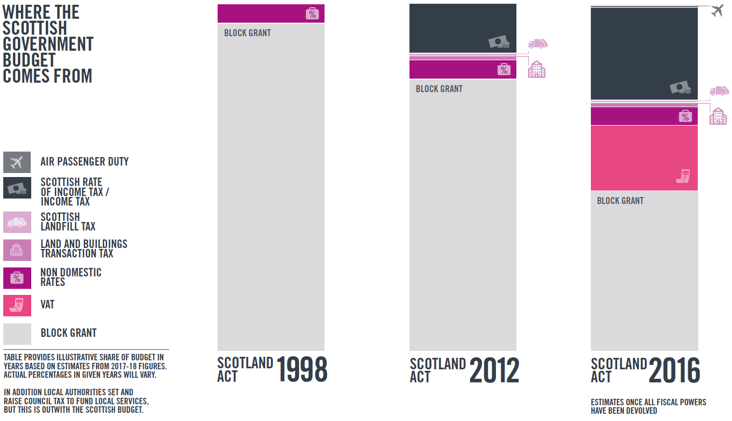Scotland's Fiscal Outlook: the Scottish Government's five-year financial strategy
The medium-term financial strategy is a key part of the revised Parliamentary budget process that has arisen out of the Budget Process Review Group.
1. Introduction
1.1. The purpose of this document is to set out a medium-term view of Scotland's public finances and the Scottish Government's broad approach to using the new financial powers that were provided through the Scotland Acts 2012 and 2016.
1.2. This is the first time that this document has been produced and it is expected to develop further in future years as more information becomes available and experience of working within the Fiscal Framework grows.
1.3. The Scottish Government has implemented a number of new fiscal powers in recent years and is implementing the remaining new powers against the background of the UK's exit from the EU, the potential economic impact of which will be a factor both in the tax revenues likely to be raised in Scotland and in future spending decisions. Despite the introduction of these new powers, the fiscal outlook remains largely dependent on spending decisions made by the UK Government.
1.4. The period since the introduction of Land and Buildings Transaction Tax ( LBTT) and Scottish Landfill Tax ( SLfT) in April 2015 has been one of unprecedented change in Scotland's fiscal landscape. Revenues raised in Scotland up to financial year 2014-15 made up under 10 per cent of the overall funding for devolved expenditure; by 2020‑21, with the assignment of Value Added Tax ( VAT), they will make up approximately 50 per cent of that funding. In addition, the implementation of the new social security powers under the Scotland Act 2016 is the largest and most complex programme of change being delivered since devolution and is likely to provide a transfer to the Scottish Budget of more than £3.5 billion for these new responsibilities.
1.5. Figure 1.1 illustrates how these changes affect the components of funding for the Scottish Government. Once all Scotland Act 2016 fiscal powers are devolved, it is expected that approximately 50 per cent of the Scottish Government's budget will come from devolved or assigned taxes.
Figure 1.1 – Sources of Scottish Government funding

1.6. Delivering improved public services within this rapidly changing financial landscape is made more challenging by the impact of UK Government austerity. Over the decade between 2010-11 and 2019-20, Scotland's discretionary resource budget allocation – the funding for day-to-day government expenditure – has reduced by more than 9 per cent or £2.6 billion in real terms.
1.7. As set out in Chapter 6, Scottish Government analysis suggests that these real terms reductions in the budget allocations from the UK Government are likely to continue over the next five years. The central projection for HM Treasury resource budget allocations, on a like for like basis, indicates that a further real terms reduction of around 1 per cent (approximately £250 million) in resource budgets between 2018-19 and 2022-23 is likely.
1.8. While the economic and fiscal outlook has rarely been so uncertain, that only enhances the case to look further ahead, so that we are best able to adapt to fund the public services which our people and economy rely upon. In line with our Fairer Scotland vision, we will aim to do this in a way that understands the impact of our revenue generation and budget allocation decisions on the diversity of our population.
1.9. Developing a longer term financial outlook is a sensible planning mechanism for a mature government to follow. We have taken an overview of the factors above in setting out our Medium Term Financial Strategy.
1.10. In 2016, the Scottish Parliament established the Budget Process Review Group to undertake a review of the Parliament's budget process. The production of this document addresses some of the key recommendations from this group (and from Audit Scotland) and contributes to the new annual budget cycle which those recommendations introduce. It is also a contribution to our commitment to be an Open Government pioneer, and to stimulate engagement in our democratic processes throughout Scotland.
1.11. Delivering a new Medium Term Financial Strategy over multiple years as a devolved government working within a UK framework is not straightforward. The Scottish Government does not have all the flexibility and levers available to the UK Government to manage and plan its finances. For example, while the Scottish Government has the power to set the rates and bands of income tax in Scotland – but not reliefs or exemptions, including the Personal Allowance – it has no power over setting the level of VAT and no control over all other reserved taxes (including Capital Gains Tax, Corporation Tax, National Insurance Contributions and Inheritance Tax), and its borrowing powers are severely limited. We have made a Programme for Government commitment to explore how responsibility for a broader range of taxes might enable the Scottish Parliament to take more balanced budget decisions, grow the economy and tackle poverty more effectively. We will provide an update on this work in autumn 2018.
1.12. The Scottish Government intends to publish a Medium Term Financial Strategy every year and expects that this new financial planning document will develop and evolve over time to include additional information. This document does not provide a detailed five year budget, nor will it provide detail at the individual portfolio level, as currently it is not possible to provide that level of budget certainty.
1.13. If you have comments on the content or the presentation of this document, we would be delighted to have them. Please contact the Finance Co-ordination Mailbox ( finance.co-ordination@gov.sco).
Contact
There is a problem
Thanks for your feedback